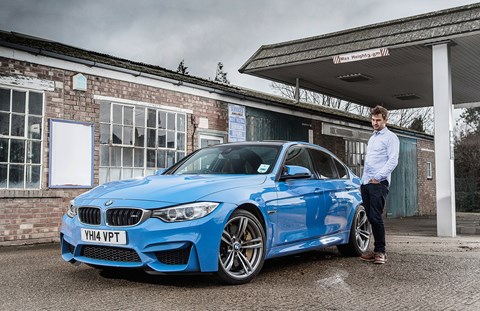► Eight months with the 4dr BMW M3
► Long-term test diary by CAR
► Few M cars have polarised like this one
Month 8 running a BMW M3: the conclusion to our long-term test
To the two perennial dinner conversation taboos of religion and politics, BMW has added a third: the F80 M3. No one seems able to agree on whether it’s a great M3, the best sports saloon currently on sale or even, more fundamentally, whether it’s any good or not. I’ve sat pinned in the passenger seat, the M3 rampaging around Brands Hatch in a storm of mighty front-end grip, obscene braking performance (thank the carbon-ceramic brakes) and rampant acceleration while a professional racing driver gushed like a wide-eyed kid. Equally I’ve sat at a dinner table while a rival development engineer, wearing an expression of genuine disbelief and sadness, outlined his case for the F80 being a spectacular M Division duffer. The truth? Somewhere in between, of course, depending on factors as diverse as the weather, your skill and confidence behind the wheel and whether or not you drove the previous-gen V8 E92…
For me the M3 does the ‘two cars in one’ thing very well. When you just want to get home it’s comfortable, roomy, quiet, equipped with the now excellent iDrive interface and blessed with enough visual and aural drama to brighten even a winter’s night on the M1. And when you’re on your own, in the mood, it’s a very quick, very capable car, the engine’s awesome reserves of any-rev power working with the tremendous brakes and meaty front-end grip to blaze down pretty much any stretch of road you care to point it at. On a circuit it’s equally imperious, particularly with the seven-speed DCT gearbox and carbon-ceramic brakes. Both will make you faster around a racetrack, though I wonder how many owners of immaculate £55k F80s will risk their precious cars in open trackday warfare. Stick to the road and I’d question the need for either (quite expensive) option. Towards the end of my time with our M3 I drove another with a manual gearbox and steel brakes and preferred both, the former for its increased sense of involvement and the latter for their more predictable, consistent light-pressure responses. Swerving the ceramic brakes and saving £6250 doesn’t take long to think about, though the bulk of the used F80s currently on sale feature the DCT gearbox, suggesting its £2645 is justifiable when you consider the very quick, satisfying shifts in manual mode and the opportunity for languid, fully-auto miles when you’re feeling lazy or stuck in traffic.
Critics return and again and again to the engine and the apparent discord between the precise, feelsome front end and the car’s fairly wayward rear. True, the engine is an odd fish. Its curious noises and ultra-grunty, almost über-diesel delivery don’t encourage the kind of wild proclamations of love inspired by, say, most AMG engines. And there’s no doubt the chassis can scare if you’re careless, lacking in bravery or it’s winter. The better the weather, the more seat time you have in the car and the more fond you are of oversteer, the more you’ll like it. Which perhaps explains why the likes of Chris Chilton didn’t want to give the M3 back, and why my fingers were clasped less firmly around its keys when the BMW’s last day dawned. The F80 M3 is an easy car to admire but a harder one to love.
By Ben Miller
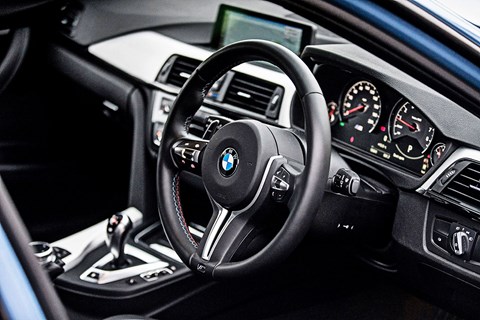
Month 7 running a BMW M3 F80: isn't it nice when everything just works?
While some may baulk at the idea of a £67k car that shares much of its interior architecture with a £24k one, the upside is comfort and sound ergonomics as standard. Honed over decades using teeming ranks of 320d pilots as guinea pigs, almost everything about the inside of the 3-series – and therefore the M3 – just works, even iDrive. BMW’s infamous interface has come a long way since its baffling early iterations. Jump aboard and within moments you’ll be merrily charging through the M3’s various systems, popping Brands Hatch into the nav, re-configuring your preferred M modes (two pre-bundled personal preferences for the various levels of steering, throttle, suspension and M-diff aggression), dialing-up some much-needed Taylor Swift and checking your oil, even before you’re off the drive.
Highlights? The admittedly M3-specific seats and the head-up display. At £825 the HUD, like Waitrose Essential hummus, is hard to describe as indispensible but it is very good, especially the full M set-up with speed (too fast), gear (largely immaterial), revs and speed limit.
By Ben Miller
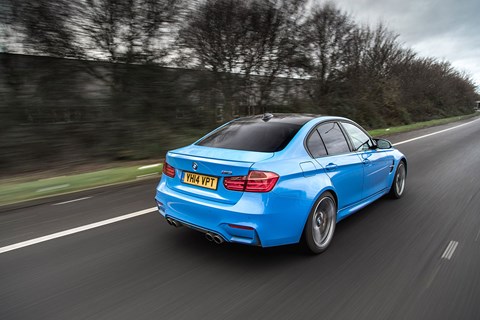
BMW M3 diary notes: not as good as it used to be?
We've lived with our BMW hotshot for a few months now and I'm afraid I still haven't warmed to it. The latest M3 seems to have lost some of the magic connection of earlier models. I've driven a fair smattering of M3s from E30 early-birds (divine!) through the E46, E92 and now the current-day F80. Only the E36 has escaped my mitts, and by all accounts that's no great loss.
It's all about the cylinder decapitation: from the very moment you thumb the starter button, the straight six moos and whirrs and grates with a harsh, guttural clatter, where its V8 predecessor sang. When cold, the noise is startlingly uncharismatic and while the rattle subsides a little when warmed-through, it's poles apart from the E92 long-termer CAR magazine was lucky enough to run last time around.
There's no arguing with the thrust on offer, mind. It's mind-warp fast with that omni-present 406lb ft of torque from the twin-turbo motor - and the seven-speed twin-clutch transmission is smooth, quick and more v2.0 in execution than earlier DCT iterations. It's just the way it goes about its business, the fact you know longer chase the redline with a 4.0 V8 willing you on, the noise... It's a common downsizing complaint and I think this is a rare BMW hiccup. I'm afraid I'm in the 'BMW M3 Not As Good As It Used To Be' camp.
By Tim Pollard
Month 6 running a BMW M3: making haste while the sun shines
Last month’s post-pheasant repairs rumble on – the parking sensor (below) was too badly injured to be re-fitted. A replacement’s on order from Germany. They’re colour-specific and, unlike the headlight washer covers, can’t be painted by your dealer.
That's a minor irritation lost in a sea of satisfying naughtiness now that the weather’s better. With a little of Andy Priaulx’s go-faster advice (see Month 4 below) ringing in my ears, the M3 and I have been enjoying the increased grip. If you’re always late to appointments, meet BMW’s £55k cure.
By Ben Miller
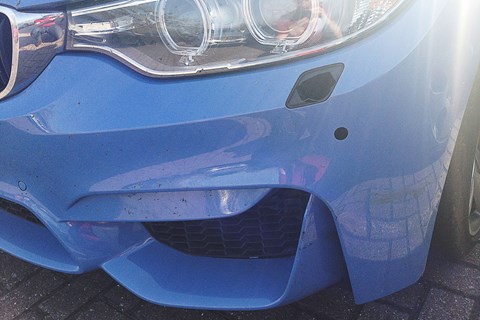
Month 5 running a BMW M3 F80: bumper meets pheasant, results unpleasant
Death and destruction as the BMW and a pheasant meet at motorway speeds. Sheer physics (and a bit of biology, some of which is still stuck between the panels) dictated the bird came off worse, and it did. But the M3 had its nose bloodied. The nearside headlight washer hose and parking sensor were both knocked from their mounts, while the washer nozzle cover went walkies. The estimate is £287.72, £45.50 of which is painting the stamp-sized cover Yas Marina blue…
By Ben Miller
Month 4 running a BMW M3: hot-lapping with touring car ace Andy Priaulx!
‘I love these cars – awesome engine,’ proclaims Andy Priaulx MBE as he jumps into our M3 beside me. Without breaking his flow he adjusts the driving position, knocks off the traction control and tells me about the M3/M4 calibration work he helped with. ‘We tried various steering and M-diff settings,’ he explains. ‘BMW wanted feedback on steering weight and rate of response, and on the balance of the car. It’s a different animal to the V8 E92, no question, but it’s a better track car.’
If secretly Priaulx hates M’s latest fast 3-series, it’s an impressive display of false sincerity. He even manages a passable impression of excited as he takes the time to show me around Brands Hatch during a crucial British Touring Car Championship pre-season test. And this year BMW’s tin-top king (Priaulx won four European and World touring car titles with the marque between 2004 and 2007) is a busy man. He’s back in the BTCC for the first time in more than a decade and, in the same season, Priaulx’s also contesting two different sports car championships, in Europe and the US, in two very different Z4s.
‘What you really notice about this car, compared to the V8 E92, is the really strong midrange torque and the front end’s refusal to understeer. It’s such a pointy, direct set-up, and that makes for a fast track car. There’s nothing worse than understeer.’
We rail around Druids before driving hard down the hill towards the left-hander at Graham Hill. ‘That tyre wall can hurt,’ he smiles, tipping his head at the menacing stack of part-worns lining the track.
‘BMW took some weight out of the car, which makes a difference,’ says Priaulx, his international tan a stark contrast to the pasty Anglo-Saxon hands with which I’m gripping the door handle. The M3 arrows across the circuit and momentarily reverberates as we run hungrily over the apex kerb. ‘You’ve always got to use all the track,’ he continues, proffering some advice. ‘In fact this is quite a handy exercise. I can see the track-limit sensors and they’re quite generous in places – you can’t see anything out of the BTCC car.’
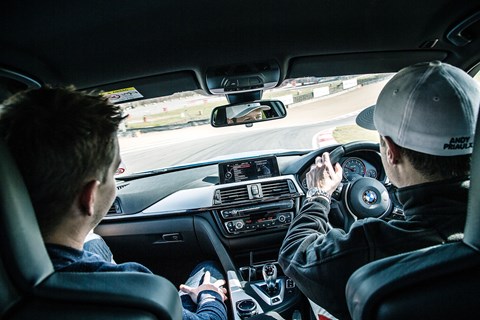
Fear of the M3’s rear end snapping sideways keeps my corner-exit throttle bravery in check but Priaulx loves the car’s playful/wayward balance. ‘This isn’t a car for the faint-hearted. But that makes it more of a racer for me. The steering rack, the front end, the diff set-up – it is lively. I loved the E92’s V8 – the engine was special – but this takes things to another level. The future’s turbo and this straight-six is a peach.’
We run through the Surtees/Clark complex with an arresting blend of speed and serenity. We’re not hanging around but there are few clues other than the g-forces: no slip or slide, no protestations from the M3’s Michelins. It’s the accuracy of Priaulx’s inputs that really impresses – there’s no fluster, no hurried stabs of corrective lock.
So I’ve got some work to do, but so too has Priaulx. He may have raced everything from Le Mans to Bathurst, Macau to Sebring, but the BTCC brings its own challenges. ‘The car’s good but these things move around a lot, they’re under-tyred, they’re heavy for the amount of horsepower and they’re about mechanical rather than aerodynamic grip,’ Priaulx tells me as he climbs into the cosy 125i. ‘They’re quite old-school too, with no traction control, a sequential gearbox and shift lever rather than a paddleshift and no auto-blipping, so you’ve got to heel-and-toe. I’m having to adapt, but that’s good – it keeps you sharp. And really the BTCC is all about the racing; plenty of contact and lots of overtaking.’
Priaulx starts today’s testing in the high 48s. Now he’s in the mid-48s. Half a dozen pit garages away the Passat CCs of Jason Plato and reigning champ (and West Surrey defector) Colin Turkington are doing 48.2s.
West Surrey boss Dick Bennetts is on the pit wall, draped in stopwatches. ‘They’re quick,’ he mutters, casting a nod in the direction of the CCs. ‘But Andy’s impressive. We’ve known him for a long time and we were keen to get him. He’s a good fit for us and he’s good for the series too, with his blue-chip sponsor.’ While costs have been wrestled under control to some extent by the Next Generation Touring Car regulations, phased in from 2011, this is still an expensive sport. ‘The cars are £280,000 each and there’s no prize money. I always think next year will be the year we make some money…’ smiles Bennetts.
As we talk Priaulx’s 1-series drops on its jacks, blares into life, rolls backwards out of the pit garage, clanks into first with a noise like a dropped anvil and heads out. ‘It’s confidence,’ Bennetts continues, ‘Tiny margins. This morning he was doing 48.8s, with a 48.4 on new tyres. Now he’s doing 48.4s on used tyres.’ (Pole position at the Brands Indy meeting last year was a 48.228.)
I make my way out to Druids. One of the Volkswagens hurtles into the top of Paddock Hill, still on the brakes, and gets hugely out of shape, the howl of its rear tyres shattering the peace. An instant later there’s the blare of the engine going to full throttle. The CC slews across the circuit, front tyres flailing, before dragging itself back into line with horsepower and determination. Then it’s through the compression at the bottom of the hill and gone.
Priaulx’s laps are less lurid – the 125i may be rear-wheel drive but it doesn’t powerslide like Fangio’s 250F. Instead Priaulx drives with an accurate, apparently effortless economy, a product perhaps of his multi-discipline CV and, latterly, his endurance racing success. When he’s black-flagged for noise – thanks to an over-fuelling flat-shift system the exhaust is cracking like a sniper’s shot with every gearchange – I make my way back to the pits. Team and driver are happy. Priaulx’s managed a consistent race distance on the tough-to-manage soft tyre and popped in a tidy 48.1 on fresh rubber.
The BMW/Priaulx pairing has been there, done that and won most of it. And still the magic’s there.
By Ben Miller
Click here to browse a secondhand E90 and E92 BMW M3 in our used-car listings.
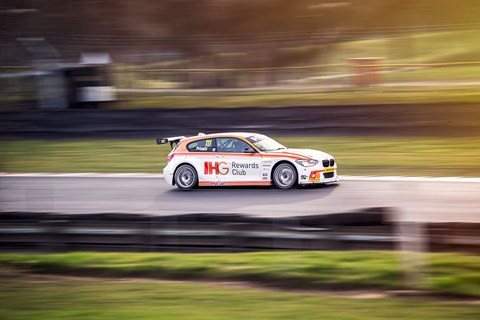
BMW M3 diary notes: too much configurability?
Are you the sort of person that has trouble making decisions? That can spend upwards of an hour choosing a birthday card, and redrafts an email a minimum of eight or nine times before clicking send (maybe just three if they’re in a real hurry)?
Then the M3 is a nightmare. Just about everything is configurable, from how cushiony you’d like the dampers to be, to how sharp or otherwise the throttle response, and how fast and weighty the steering. You can even choose from three levels of gearchange ferocity. So if you’re anything like me (God help you) there’s always the nagging doubt you might enjoy the car more if you chose a different blend of settings. So the time I’ve spent in the M3 has mostly passed in a haze of button-pressing, trying to crack some kind of Ultimate Driving Machine combination code.
Maybe that’s one of the reasons I’ve found the M3 a difficult car to bond with on the few (admittedly brief) times I’ve driven it. Whichever setting you go for, it feels a bit of a compromise; the steering can be altered from light to heavy, slow-ish to darty, but always feels a bit synthetic, there’s a bit more body movement than you might expect in all but the firmest damper mode, and the fastest gearshift setting is downright violent. It feels like the M3 would be all the better if it just had one factory setting for everything, like, well, a normal car, so you could just jump in and enjoy it.
By James Taylor
Month 3 running a BMW M3: too much power? No such thing
I’m all for the purity of fine handling over prodigious power. Having logged plenty of flying time at the controls of 205 XS Peugeots (the purist’s 205 etc.), Mercedes Sprinter vans (delicious balance, real malleability at the limit etc.) and 4bhp 1950s motorcycles (I’m better now), I’m acutely aware of the fun you can have coaxing pace from a vehicle that goes without the option of hammering between corners to keep up its average speed. It’s underdog stuff; the reason why, in those Mini-versus-Ford-Galaxie scraps the Goodwood Revival does so well, the crowd only deigns to put down its luncheon meat and get to its feet for a round-the-outside comeback from the Mini.
But there’s a problem – everyone else. The UK road network is, as you’ll know only too well if you live anywhere more built-up than Orkney, a little clogged these days. A clear run at a decent stretch of road comes along about as often as a sequel to To Kill a Mockingbird. More often than not there’s other traffic to negotiate, which is where the case for a hot-handling but firepower-bereft car comes apart. Without the pace to slip past, all that cornering proficiency goes to waste as you trundle through Northamptonshire’s most spectacular multi-apex complex at a stout 38mph, all over the Yaris ‘pace car’ ahead like a second coat of paint.
The M3 is not like this. With its turbocharged torque (406lb ft from less than 2000rpm) the F80 unlocks even sinuous roads, its prodigious acceleration peppering them with effortless and often hitherto unseen M3-specific overtaking opportunities. It’s a useful attribute, whether you’re hurrying home over hundreds of miles of A-road or, in the interests of keeping the Yas Marina blue paint clean, trying to avoid following in everyone else’s filthy-wet wake.
Talking of wet, the first time the carbon-ceramic brakes take on any real water, the reduction in braking performance is marked and – depending on your approach speed when you go for the pedal – potentially alarming. A numb pedal after a good jet-wash you expect, but a couple of puddles can be enough to take almost all the power out of the otherwise extraordinary brakes, at least for a second or two.
By Ben Miller
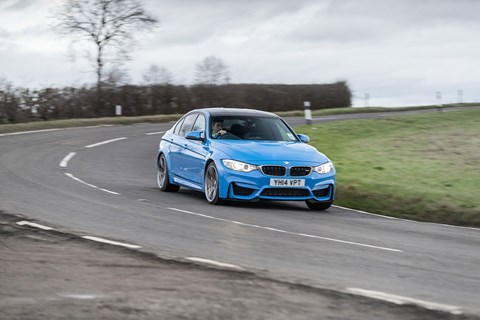
Month 2 running a BMW M3: a change of tyre pressures and a change of heart
Last month I moaned about the inclement weather and suggested that the M3 might not be the ideal car for the sixth-month Stalingrad that is the British winter. This month I’m pleased to report I’ve shed my big girl’s blouse, stopped making embarrassing excuses and started counting down the hours until my next non-essential cross-country drive: ‘We’re down to our last six pints of lactose-free semi-skimmed; won’t be long.’
What’s brought about the epiphany? There’s nothing like putting the tyre pressures right to bring a car to life; they were about 7psi down all round. That, together with switching my engine preset from the gloopy Efficient to the louder, livelier Sport, has transformed the car. Hitherto it felt like a slightly portly liability. Now I can’t get enough of its towering performance.
And for every niggle – it’s too easy to turn up the passenger’s heating when you wanted louder music; something’s creaking in the dash; bassy tracks set the speakers rattling – there’s an example of great detailing, be it the fabulous bungee nets in the boot or the brilliant head-up display. Now, must dash – we’re low on, er, turmeric.
By Ben Miller
Month 1 running a BMW M3: the introduction to our review
Shock and awe was obviously the thinking, a swift and brutal re-education. Much of my 18 years on the road has been spent in front-wheel-drive cars with less than 100bhp, and I’d even managed to convince myself there’s little need for more. Then four years ago, in a move without a shred of originality, I bought an E90 3-series, though I did briefly exhibit a spasm of non-conformity by going for the thirsty, board-stiff and painfully peaky 320SI while every other right-minded soul on the island plumps for the 320d.
Still, the 40,000 miles I’ve covered in that car represent the sum total of my rear-drive experience, and its 170bhp and hugely grippy chassis convinced me that this really was all I needed; all anyone needed, surely. Cleary I required disabusing of this notion, so now I find myself in an F80 M3, grappling to make sense of endlessly adjustable everything, three times the torque and wheelspin that follows you everywhere like a needy Labrador. Strong medicine, but it should do the trick.
The car we have on trial is a pretty top-end example of the breed, its basic price swelled by options to the tune of £12,000, to £67,000. By some margin the most indulgent are the £6250 ceramic brakes, which promise fade-free repeated hard stops in return for the market value of my eight-year-old 320SI. The power in the middle pedal is astonishing, requiring a complete recalibration of how much effort even serious slowing requires – thump them with conviction and it feels like you might do lasting damage to internal organs.
Bringing another £2645 is the seven-speed DCT transmission. You can tailor it fully to your tastes, of course, but will it prove as engaging or as satisfying as a manual? The rest of the options list comprises such niceties as sun-protection glass, the M head-up display (with speed-limit info), BMW’s advanced loudspeaker system (nearly as powerful as the twin-turbo six), excellent adaptive headlights and the aluminium blade interior trim, which certainly lifts a cabin fond of black. Time and miles will tell if going at the options list like a rabid jackal was a wise move, but already I have my doubts.
The M3 could scarcely have turned up at a worse time, with the ice warning chiming in every morning without fail, and this is my excuse for generally setting the car up in a most un-M way most mornings; comfort and efficiency all-round, with the transmission in Drive mode and on the least aggressive shift map. Adjusted thus, the M3 in a mightily refined cruiser, with the ride quality to take the sting out of Lincolnshire’s worst tarmac, and such a comfortable and well-appointed interior that it’s a shame the car’s thirst (22mpg thus far) means visiting petrol stations at least every 250 miles.
But driving an M3 in this way feels like missing the point spectacularly, so here’s hoping for a very brief, very mild winter.
By Ben Miller
